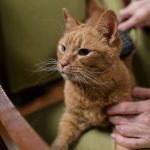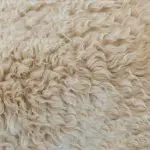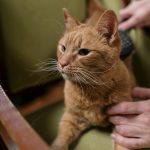Velvet is soft and cozy, making it appealing for your cat’s naps and lounging. However, its delicate pile is prone to snagging and wear from sharp claws, so it’s not the most durable choice for homes with cats. You’ll need to provide scratching posts and trim nails to protect your furniture. While velvet feels luxurious, it attracts fur and can show damage easily. Keep going to discover how velvet compares with other fabrics and ways to safeguard it.
Table of Contents
Key Takeaways
- Velvet’s soft texture attracts cats but is highly vulnerable to damage from their claws and scratching behavior.
- The fabric easily snags, pulls, and frays under repeated cat scratching, reducing its durability.
- Velvet provides a cozy, warm surface that appeals to cats for napping and kneading activities.
- Compared to leather or microfiber, velvet is less resistant to scratches and harder to maintain with pets.
- Protect velvet furniture with nail trims, scratching posts, deterrents, and covers to prolong its appearance.
Understanding Velvet Fabric: Composition and Characteristics
Velvet is a soft, luxurious fabric known for its smooth texture and rich appearance. When you look closer, you’ll find it’s made by weaving two layers of fabric simultaneously, then cutting them apart to create that distinctive pile. This pile gives velvet its plush feel and depth.
You’ll encounter various types, including silk, cotton, polyester, and blends, each offering different durability and sheen. Silk velvet feels delicate and shiny, while cotton velvet is more breathable but less glossy. Polyester velvet often balances durability and cost-effectiveness, making it popular for upholstery.
Knowing these details helps you understand how velvet behaves under different conditions, which is essential when considering it for a home with cats. You’ll appreciate the fabric’s elegance but also recognize its maintenance needs.
How Velvet Reacts to Cat Claws
While the luxurious feel of velvet adds a touch of elegance to your home, it can also be vulnerable when your cat’s claws come into contact with it.
Velvet’s soft pile easily catches on sharp claws, causing pulls, snags, and visible damage. Once snagged, the fabric’s texture can become uneven, and the smooth surface may develop unsightly runs.
Velvet’s delicate pile is prone to snagging and damage from sharp cat claws, disrupting its smooth texture.
You’ll notice that velvet doesn’t resist scratching well; repeated clawing can quickly wear down the fibers, leading to fraying or bare spots.
If your cat enjoys scratching furniture, velvet requires extra care or protection to maintain its appearance. Using nail caps or providing ample scratching posts can help minimize damage.
Being aware of velvet’s sensitivity helps you protect your investment while keeping your cat safe and happy.
Comfort and Appeal of Velvet for Cats
Because cats are drawn to soft, warm surfaces, they often find velvet especially inviting for naps and lounging.
When your cat curls up on a velvet cushion or sofa, they enjoy the plush texture that cushions their joints and traps warmth, creating a cozy spot.
Velvet’s smooth pile also appeals to their tactile senses, making it a favorite resting place.
You’ll notice your cat kneading or purring more when resting on velvet due to this comfort.
However, while velvet provides a luxurious feel, you should watch for hair accumulation since velvet tends to hold onto fur.
Comparing Velvet to Other Common Upholstery Fabrics
When you compare velvet to other upholstery fabrics, you’ll notice differences in durability against cat claws, comfort, and texture.
You’ll also want to contemplate how easy each fabric is to clean and maintain with a curious cat around.
Let’s look at how velvet stacks up against common options like leather and microfiber.
Durability Against Cat Claws
How well does velvet hold up against your cat’s sharp claws compared to other upholstery fabrics?
Velvet tends to be less durable when it comes to resisting cat scratches. Its soft, plush surface can snag easily, leading to visible pulls and damage faster than sturdier fabrics like leather or tightly woven microfiber.
Materials like canvas or denim offer more resistance due to their dense weave, making them better choices if claw durability is a priority.
While velvet’s luxurious look is appealing, it won’t withstand repeated clawing without showing wear. If your cat loves to scratch furniture, you might find velvet requires more frequent repairs or replacement.
Choosing fabrics with tighter weaves and stronger fibers will give you better claw resistance over time.
Comfort and Texture Differences
Although velvet offers a luxurious, soft feel that many cats find irresistible, its texture differs considerably from other common upholstery fabrics like leather, microfiber, or cotton.
When choosing a fabric for your home, you want to evaluate how your cat will interact with it. Velvet’s plush surface feels warm and cozy, inviting your cat to snuggle. In contrast, leather is smooth and cool, which some cats may find less appealing.
Microfiber offers a slightly textured feel, making it a good middle ground, while cotton tends to be breathable but less soft.
Here’s a quick comparison:
- Velvet: soft, plush, warm
- Leather: smooth, cool, firm
- Microfiber: soft, slightly textured
- Cotton: breathable, natural feel
- Linen: coarse, firm texture
This helps you pick what suits your cat’s comfort best.
Maintenance and Cleaning Ease
Velvet’s inviting softness makes it a favorite spot for cats to lounge, but you’ll want to contemplate how easy it’s to keep clean compared to other fabrics.
Velvet tends to attract pet hair and can trap dirt in its dense fibers, making regular vacuuming essential. Unlike leather or microfiber, velvet isn’t as resistant to stains, so spills need prompt attention to avoid lasting marks.
You’ll find that spot cleaning requires gentle care to prevent damaging the fabric’s delicate pile. In contrast, microfiber offers easier maintenance with its tightly woven structure, and leather wipes down effortlessly.
If you want a cozy look without high upkeep, consider these factors carefully. Velvet’s charm is undeniable, but it demands more effort to stay looking fresh in a pet-friendly home.
Tips for Protecting Velvet Furniture From Cat Damage
Since cats love to scratch and climb, protecting your velvet furniture requires some thoughtful strategies. You want to keep your velvet looking great without discouraging your cat’s natural behavior.
Start by providing alternative scratching options and using deterrents that won’t harm your furniture or pet. Consistency is key to training your cat away from velvet pieces.
Here are five effective tips to protect your velvet furniture from cat damage:
- Place scratching posts or pads nearby to redirect scratching.
- Use double-sided tape or furniture protectors on velvet surfaces.
- Trim your cat’s nails regularly to reduce damage.
- Apply pet-safe deterrent sprays on velvet areas.
- Cover vulnerable spots with removable slipcovers when not in use.
These steps help maintain your velvet’s elegance while keeping your cat happy.
Alternative Cat-Friendly Fabrics to Consider
When choosing furniture fabrics with cats in mind, you want materials that can withstand scratching and are easy to clean.
Look for tightly woven fabrics like microfiber or synthetic blends, which resist claws better than loose weaves. Leather is another durable option; while it can show scratches, it’s simple to wipe down and doesn’t trap pet hair.
Canvas and denim also stand up well to wear and tear, plus they’re easy to wash.
Avoid delicate fabrics like silk or loosely woven materials, which cats can quickly damage.
By opting for these cat-friendly fabrics, you’ll protect your furniture while keeping a cozy, pet-friendly home.
Frequently Asked Questions
Can Velvet Cause Allergies in Cats?
You might find velvet doesn’t directly cause allergies in cats, but dust and fibers trapped in it can irritate their respiratory system. Keep velvet clean to reduce allergens and guarantee your cat stays comfortable and healthy.
Is Velvet Safe if Cats Chew on It?
If your cat chews on velvet, it’s not safe. Velvet fibers can cause choking or digestive blockages. You should discourage chewing and provide safer, cat-friendly toys to keep your feline healthy and happy.
How Do Cats Typically Behave Around Velvet Toys?
You’ll notice cats often show curiosity and gentle pawing with velvet toys, enjoying their soft texture. They might nibble or scratch lightly but usually avoid aggressive biting, making velvet toys appealing yet safe for play.
Does Velvet Retain Pet Odors More Than Other Fabrics?
You’ll find velvet tends to trap pet odors more than smoother fabrics because its dense fibers hold onto smells. Regular cleaning helps, but if you want less odor retention, consider fabrics like leather or tightly woven cotton instead.
Can Velvet Upholstery Affect Cat Shedding Patterns?
You might think velvet upholstery affects your cat’s shedding, but it doesn’t influence their hair loss. Instead, it just shows more fur, so you’ll notice shedding more, not that your cat sheds less or more.
- Chamois Fabric at Michaels: What to Expect - June 22, 2025
- Chamois Fabric Wholesale: Top Suppliers and Manufacturers - June 22, 2025
- Micro Chamois Fabric by the Yard: Best Suppliers - June 22, 2025






